
After 50 years of progress, how prepared are
women for retirement?
Trends and Issues
June 2022
Title IX of the Education Amendments of 1972 prohibits sex
discrimination (including pregnancy, sexual orientation, and gender
identity) in any education program or activity receiving federal nancial
assistance.
In the 50 years since the enactment of Title IX, women have made
enormous strides in terms of educational attainment, work, and
earnings. Although a wage gap by gender persists, women’s progress
in the workforce has clearly enhanced their economic status as
individuals. On the other hand, women have chosen to spend less
of their adult life married, and the decision to eschew the potential
support of a spouse could have put them more at risk economically.
This study uses the Health and Retirement Study to document the
economic gains and the changing demographic proles of women and
then assesses the extent to which they are prepared for retirement.
Since the trends in both economic gains and marriage have differed for
Black and White women, the results are reported by race as well as for
all women.
Alicia H. Munnell
Center for Retirement
Research, Boston College
TIAA Institute Fellow
Siyan Liu
Center for Retirement
Research, Boston College
Laura D. Quinby
Center for Retirement
Research, Boston College
Any opinions expressed herein are those of the authors, and do not necessarily represent the views of TIAA, the TIAA Institute or any other organization with which the authors
are afliated.

After 50 years of progress, how prepared are women for retirement? 2
This review shows that women have gained in educational
attainment, work force activity, and earnings, and this
progress has translated into wealth. Moreover, women
do not appear to have undone their economic gains since
Title IX’s passage by opting to spend more time on their
own—those who spend the majority of their adult life
single are as well prepared for retirement as married
couples.
Overview
The short story is that single women have always
worked, but married women have not (see Figure 1). As
time passed, some married women started to work and
some did not, and this variability made the labor supply
of married women the subject of an enormous body of
research.
Figure 1. Labor force participation of single, married, and all women, ages 35–44, 1900-2020
Although this study focuses on changes in the half
century since Title IX, it is helpful to take a step back
and start the discussion with a look at the work habits
of married women over a longer period. Claudia Goldin
divides the history of women and their labor force activity
into four periods.
1
Late 19
th
Century to the 1920s. Some young and
non-married women worked as piece workers in
manufacturing or as maids. However, virtually no married
women were in the labor force. Because work was
generally very unpleasant, a huge stigma was attached
to wives working outside the home. Only the poor needed
their wives to work at physically demanding jobs that
involved long hours. Economists have estimated income
and substitution effects associated with women’s
labor force activity over time. That is, how responsive
is the wife’s labor supply to the household’s income,
typically the husband’s earnings, and to the wage she
can earn in the labor market. During this period, as the
husband’s income increased above fairly modest levels,
the likelihood that a married woman would work declined
substantially. At the same time, an increase in the wage
was unlikely to coax additional work activity on the part of
women.
1930s to 1950. During these two decades, the labor
force activity of prime-age married women rose from
10 percent to 25 percent. One reason is that jobs got
less physically demanding and more appealing—ofce
jobs rather than manufacturing jobs. New technologies,
such as in-home appliances also made housework less
1 Goldin (2006).
Source: U.S. Census Bureau, American Community Survey (1900-2020).
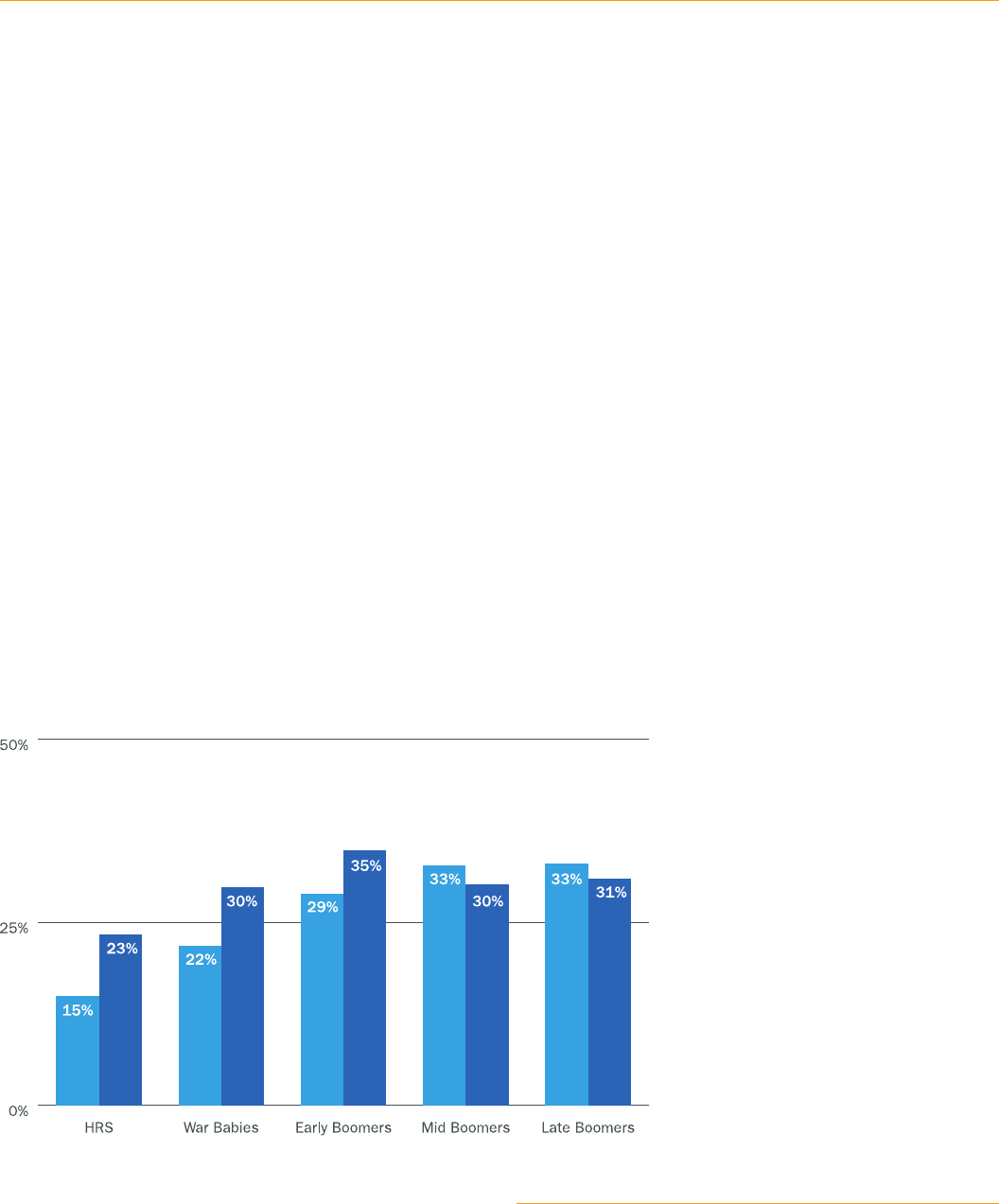
After 50 years of progress, how prepared are women for retirement? 3
time-consuming. And the possibility of working part-
time arose in the 1940s and became widespread in the
1950s, which was attractive to women who were primarily
responsible for home and children.
1950s to 1970s. In this period, the labor force
participation of prime-age married women rose from
25 percent to almost 50 percent. The demand for
women’s labor was strong. Many entered the labor force
as secretaries, teachers, and nurses. While they came
fully trained to these positions, many did not expect
advancement, and treated their work as a job not as an
element of their identity. Yet they ended up spending a
substantial portion of their life employed.
2
1970s to the Present. Young women growing up in the
1960s could see that it was feasible to spend most
of their lives employed. One way they responded was
to invest in their education. They went to college in
increasing numbers, majored in career-oriented subjects,
and were more likely to continue their education in
professional and graduate schools. The advent of the
contraceptive pill allowed many to postpone marriage
and establish themselves professionally. As many placed
their career on equal footing with their marriage, the labor
supply of married women became even less responsive
than before to their husband’s earnings.
Progress from the 1970s to the present
Since this study focuses on the 50th anniversary of
Title IX, the analysis looks at the achievements of
women in terms of education, work, and earnings since
the enactment of that legislation. The data come from
the Health and Retirement Study (HRS), a longitudinal
nationally representative survey that has interviewed
people over age 50 every two years since 1992 (most
recently 2020). The survey contains information on ve
cohorts of respondents. The original HRS cohort (born
1931-41) and the War Babies (1942-47), who reached
age 20 in the 1950s and the 1960s, can serve as a
base of comparison. The Early Boomers (1948-53), Mid
Boomers (1954-59), and Late Boomers (1960-1965),
who reached age 20 in the 1970s and 1980s, show the
economic gains since the passage of Title IX.
To provide a sense of progress on the educational front,
Figure 2 shows the percentage of women and men who
ended up with a college degree. Two facts stand out.
First, the share of women with a degree has increased
enormously, from 15 percent for those born in the 1930s
to one third for Late Boomers, born in the early 1960s.
Second, for recent cohorts, a greater percentage of
women than men ended up with a college degree.
Figure 2. Percentage of women and men with a college degree, by cohort
Source: Authors’ calculations from the University of Michigan, Health and Retirement Study (HRS) (1992-2020).
2 Goldin (2006).
● Women
● Men

After 50 years of progress, how prepared are women for retirement? 4
That pattern by gender reects the outcome for Whites,
where the percentage with a college degree is ve
percentage points higher for women than for men
(see Figure 3). For Blacks, the percentages for the two
genders are equal. Figure 3 also shows that, while the
outcomes for both Black and White women have improved
markedly, educational progress for Black women has
lagged behind that of their White counterparts.
3 Around 60 percent of HRS respondents agree to link their survey data with
administrative earnings records from the Social Security Administration.
Figure 3. Percentage of women and men with a college degree for HRS and Late Boomer cohorts, by race
Source: Authors’ calculations from the HRS (1992-2020).
The next two gures repeat the same exercise for labor
force activity. Although the HRS does not interview people
until age 50, administrative data on lifetime earnings
is available for a large subsample.
3
Figure 4 shows
the labor force participation rate for women and men
between ages 35-44 for the ve cohorts. The percentage
of prime-age women in the labor force increased from
57 percent for the earliest cohort to 76 percent for the
Late Boomers. The increase has markedly reduced the
differential between women and their male counterparts
for whom labor force participation rates have remained
relatively constant between 85 percent and 88 percent.
● Women
● Men
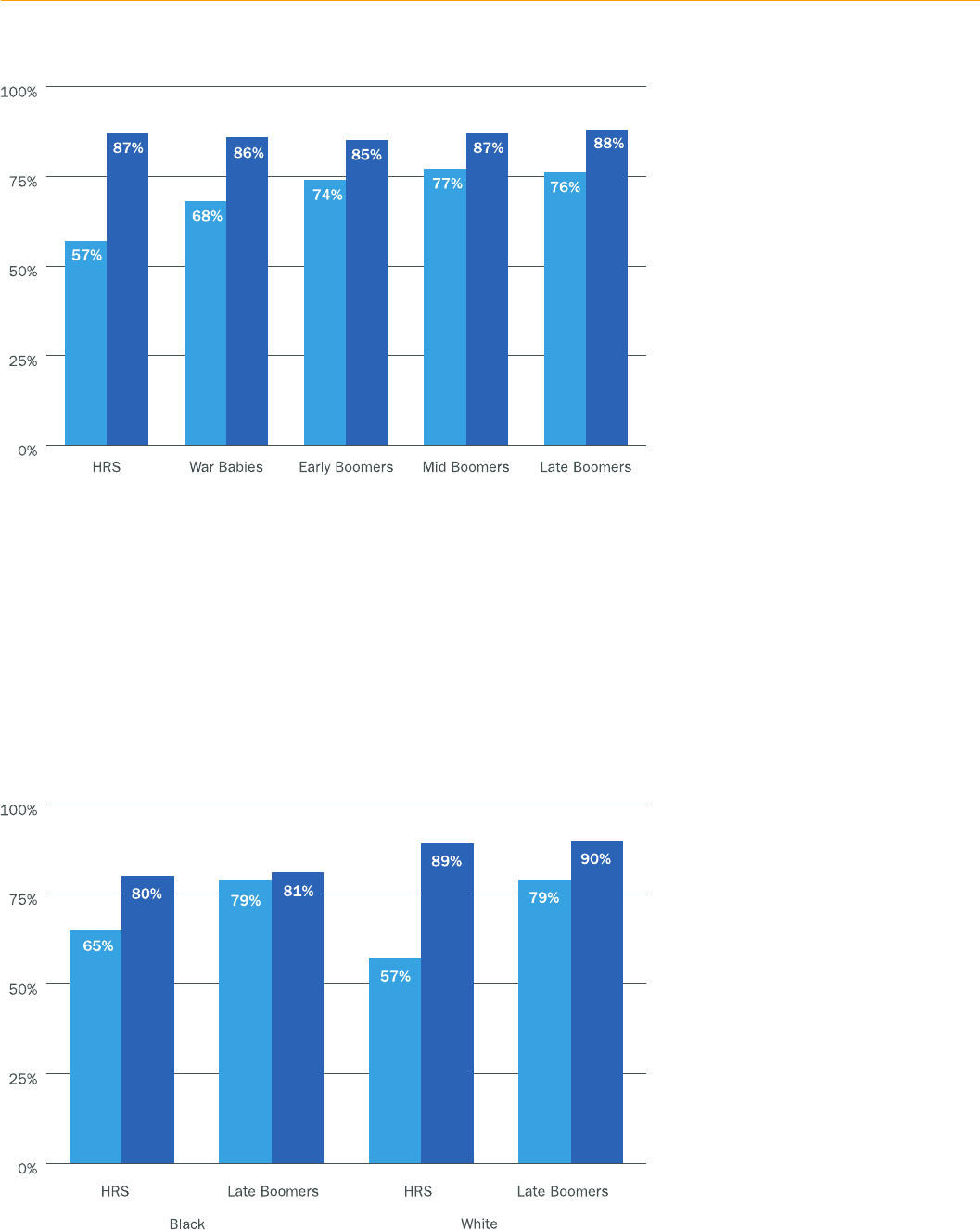
After 50 years of progress, how prepared are women for retirement? 5
The pattern by race is interesting. As expected, in both
cases, women’s increased participation has narrowed
the gender gap. But because historically more Black than
White women worked—perhaps out of necessity—the
increase in participation for White women has exceeded
those for their Black counterparts (see Figure 5). This
more rapid increase for White women, combined with a
lower starting point, has produced an equal labor force
participation rate for prime-age Black and White women.
Finally, because the participation rate for Black men is
about 10 percentage points lower than for White men,
the gender gap has virtually disappeared for Blacks but
remains for Whites.
Figure 4. Labor force participation rate of individuals ages 35–44 by cohort
Figure 5. Labor force participation rate of individuals ages 35–44 for HRS and Late Boomer cohorts, by race
Source: Authors’ calculations from the HRS (1992-2020).
Source: Authors’ calculations from the HRS (1992-2020).
● Women
● Men
● Women
● Men
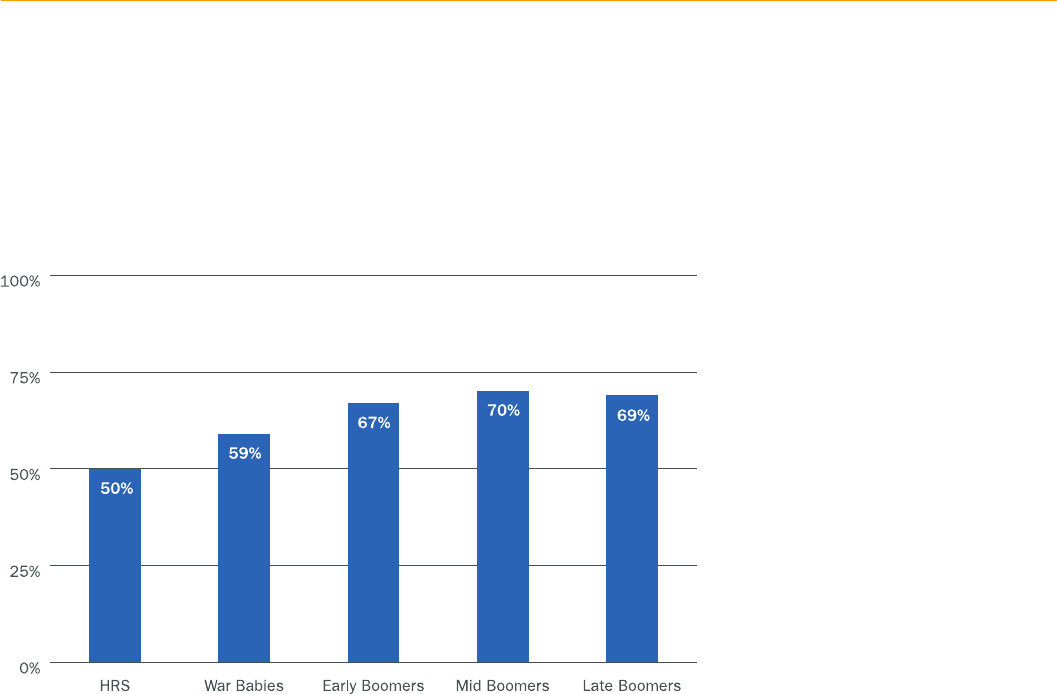
After 50 years of progress, how prepared are women for retirement? 6
Not surprisingly, the increased educational attainment
and greater labor force activity of women have led to
higher earnings. Unfortunately, the HRS administrative
earnings data do not have information on hours worked,
so in order to identify full-time workers it is necessary to
turn to the Current Population Survey. For this exercise,
we assigned workers to cohorts based on their year of
birth and then observed them at ages 35-44. The results,
reported in Figure 6, show that women’s earnings have
increased from 50 percent of men’s to about 70 percent
for the Boomers.
Figure 6. Women’s earnings as a percentage of men’s, full-time individuals ages 35–44
Source: Authors’ calculations from the U.S. Census Bureau, Current Population Survey (CPS) (1967-2009).
Repeating the exercise by race shows that Black
women, too, have gained relative to men (see Figure 7).
Interestingly, both historic and current ratios are higher
for Black than for White women. This pattern, however,
says more about the low earnings of Black men, as the
earnings of full-time Black women are quite similar to
those for their White counterparts.
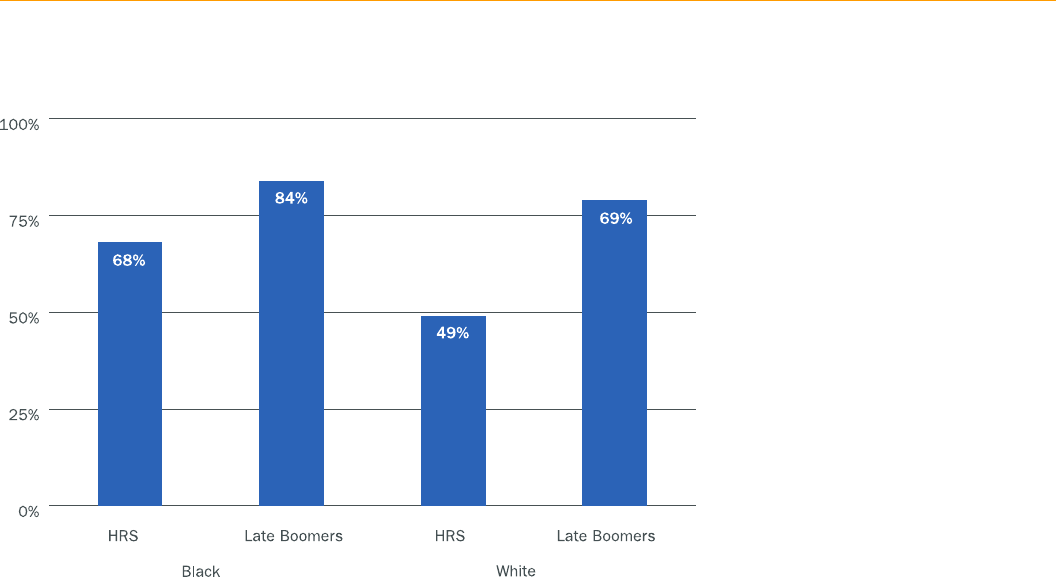
After 50 years of progress, how prepared are women for retirement? 7
In summary, the economic life of women has changed
dramatically. More have graduated from college, more
participate in the labor force, and they earn more relative
to men. Women’s progress in the workforce has clearly
enhanced their economic status as individuals. The
question for this report, however, is the extent to which
women are prepared for retirement. That answer depends
not only on the economics of women as individuals,
but also their living arrangements. To the extent that
women have moved away from marriage and eschewed
the potential support of a spouse—who is more likely
to have a better job and higher earnings—both during
their working life and in retirement, they could have put
themselves more at risk economically.
The decline of marriage
To quantify the extent to which marriage patterns have
changed, we once again turn to the HRS to calculate
the percentage of each woman’s adult life (ages 20 +)
spent in marriage. For comparisons across cohorts, one
would like to include in the calculation all years between
age 20 and the death of the respondent. Such a broad
span is not possible, however, because women added
to the sample in recent years are still quite young. For
example, the Late Boomers were added in 2016, so as
of 2020 this group includes women who were only in
their mid-to-late 50s. As a result, estimates need to be
made for these later cohorts. Three sets of calculations
are presented to illustrate that the assessment is not
particularly sensitive to the approach taken.
To establish a baseline requiring no estimates, the
starting point is marriage patterns between age 20 and
the most recent interview. The number of years over this
span is totaled for each woman and then added across
all women to get “total women years.” The number of
years married during this span is then totaled for each
woman and added over all women to get “years married.”
Dividing “total years married” by “total woman years”
yields the percentage of years married for each cohort.
One concern with using age 20 to the last interview is
that the Late Boomers in 2020 were 54-60, while the
original HRS cohort in 2020 were 79-89. Therefore, the
“last-interview” results could understate the decline
because the most recent cohorts have spent virtually
no years as widows. To address this concern, a second
approach uses a standard age for each cohort. Of
course, excluding information at older ages when women
are more likely to be widowed increases the percentage
of years married throughout, but most likely provides a
better picture of decline over time.
Figure 7. Women’s earnings as a percentage of men’s, full-time individuals ages 35–44, by race for HRS
and Late Boomer cohorts
Source: Authors’ calculations from the CPS (1967-2009).

After 50 years of progress, how prepared are women for retirement? 8
The nal approach takes advantage of all the available
data and makes an estimate for potential widowhood for
younger women. This estimate starts with the ratio of the
percentage of years spent married for the HRS cohort as
of last interview (79-89) to the percentage for this same
cohort at ages 54-60 (71/77 = .92). This ratio, which
shows how the percentage of years married is reduced
when more years are included, is applied to the reported
percentages at ages 54-60 for the younger cohorts.
The results for all three calculations are shown in Table
1. Regardless of the approach taken, the percentage of
women’s adult years spent married has declined sharply
from over 70 percent for the HRS cohort to an estimated
44 percent for the Late Boomers.
How did this dramatic change come about? First, the
average age of rst marriage rose by about 4 years
between the HRS cohort and the Late Boomers (see
Table 2).
4
Second, a greater proportion of women never
4 Haines (1996) documents an increase in the age at rst marriage for women that
began in 1950 and continued through 1990. Loughran (2002) attributes some of
this increase to rising male wage inequality over the same time period. Goldin and
Katz (2002) attribute some of the increase to the introduction of the birth control
pill in the 1960s.
5 As Stevenson and Wolfers (2007) note, divorce rates actually peaked in the early
1980s and have fallen slightly since. In this context, the sharp increase in the
share of women divorced between the HRS cohort and Early Boomers (who would
have been in their 30s around the time of the peak) makes sense, followed by the
slight decline seen for the Mid Boomers.
marry, rising from 4 percent in the HRS cohort to 15
percent for Late Boomers. And third, more women get
divorced.
5
Table 1. Percentage of years that women spend married by cohort, 2020
Age span HRS Cohort War Babies Early Boomers Mid Boomers Late Boomers
Ages 20 to last interview 71.0% 71.2% 59.3% 54.5% 48.1%
Ages 20 to 54–60 77.1 73.2 60.0 54.0 48.1
Ages 20 to 79–89 (est.) 71.0 67.5 55.3 49.7 44.3
Source: Authors’ calculations from the HRS (1992-2020).
Table 2. Women’s marriage patterns by cohort, 2020
Marriage pattern HRS Cohort War Babies Early Boomers Mid Boomers Late Boomers
Avg. age of rst marriage 21.4 21.6 22.8 24.3 25.3
% never married 3.9% 4.2% 8.7% 11.9% 14.6%
% divorced
*
34.1 38.7 49.2 48.3 49.7
*Includes any woman who was ever divorced.
Source: Authors’ calculations from the HRS (1992-2014).

After 50 years of progress, how prepared are women for retirement? 9
The impact of these changing patterns on the percentage
of “woman years” married is shown in Figure 8. The
substantial increase in years spent either divorced or
“not married” (i.e., prior to a rst marriage or because the
individual never got married) has reduced the percentage
of years married.
Figure 8. Percentage of years widowed, divorced, married, and not married, by cohort
Source: Authors’ calculations from the HRS (1992-2020).
While women in the aggregate are spending less and less
time in marriage, the question is whether this decline is
similar across socioeconomic groups. To examine this
issue, we replicate the exercise for Whites versus Blacks
and for those with a college degree versus those with
less than college. For simplicity, we compare only the
HRS cohort with the Late Boomers.
While the percentage of years married declined
signicantly for both White and Black women, three
differences are worth noting (see Figure 9). First, Black
women have always spent a smaller percentage of years
married than White women have. Second, the decline
in the percentage of years married is greater for Black
women than White women.
6
Third, the reasons for the
decline are different. Whereas White women saw a more
than doubling of years spent divorced, Black women did
not. In contrast, Black women experienced a much larger
increase in the percentage of years not married, making
it the single largest category for them.
6 Both the lower level of marriage among Blacks and the widening marriage gap have
been documented elsewhere, for example in Raley, Sweeney, and Wondra (2015).
● Widowed
● Divorced
● Married
● Not married
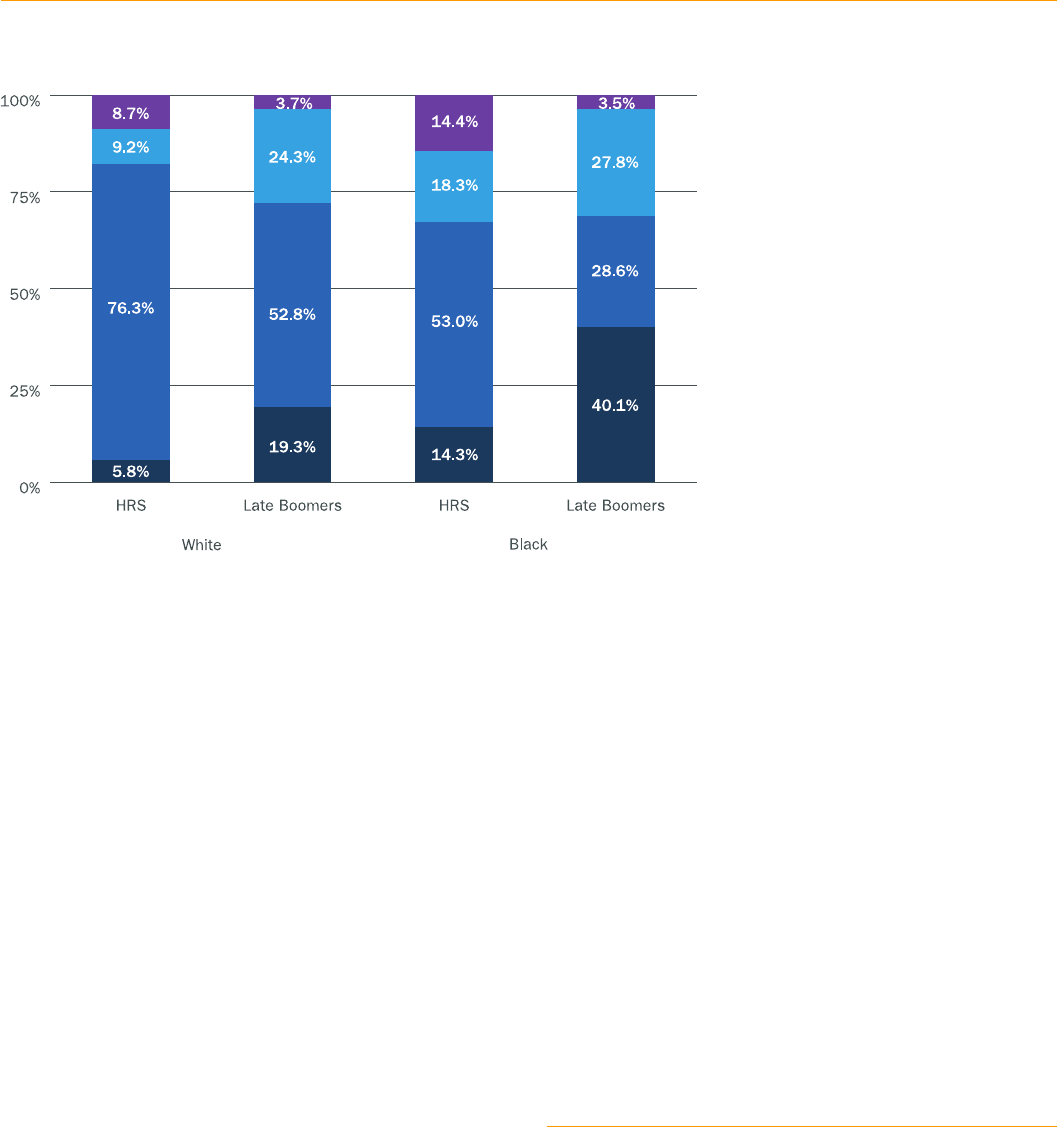
After 50 years of progress, how prepared are women for retirement? 10
In contrast to the enormous difference in marital patterns
by race, the pattern by educational attainment looks
very similar (see Figure 10).
7
For both those with a
college education and those with less than college, the
percentage of years spent married declined from about
Figure 9. Percentage of years widowed, divorced, married, and not married, by cohort and race
Source: Authors’ calculations from the HRS (1992-2020).
7 Statistics are restricted to females who enter the HRS survey before age 60.
Observations are selected at the last wave in which the individual falls within ages
52-58, inclusive.
8 Although recent evidence has suggested that these numbers may diverge for
future birth cohorts of women, at least through the Mid Boomer cohort, the trends
look similar. For example, Lundberg, Pollak, and Stearns (2016) nd that the
marriage rates of 30- to 44-year-olds between those with and without a college
education were very similar through the mid-1980s (when the Mid Boomers would
have been in their 30s) and have been diverging ever since.
70 percent to about 45 percent between the HRS and
Late Boomer cohorts. The increase in the percentage of
years not married or divorced was also consistent across
educational groups.
8
● Widowed
● Divorced
● Married
● Not married
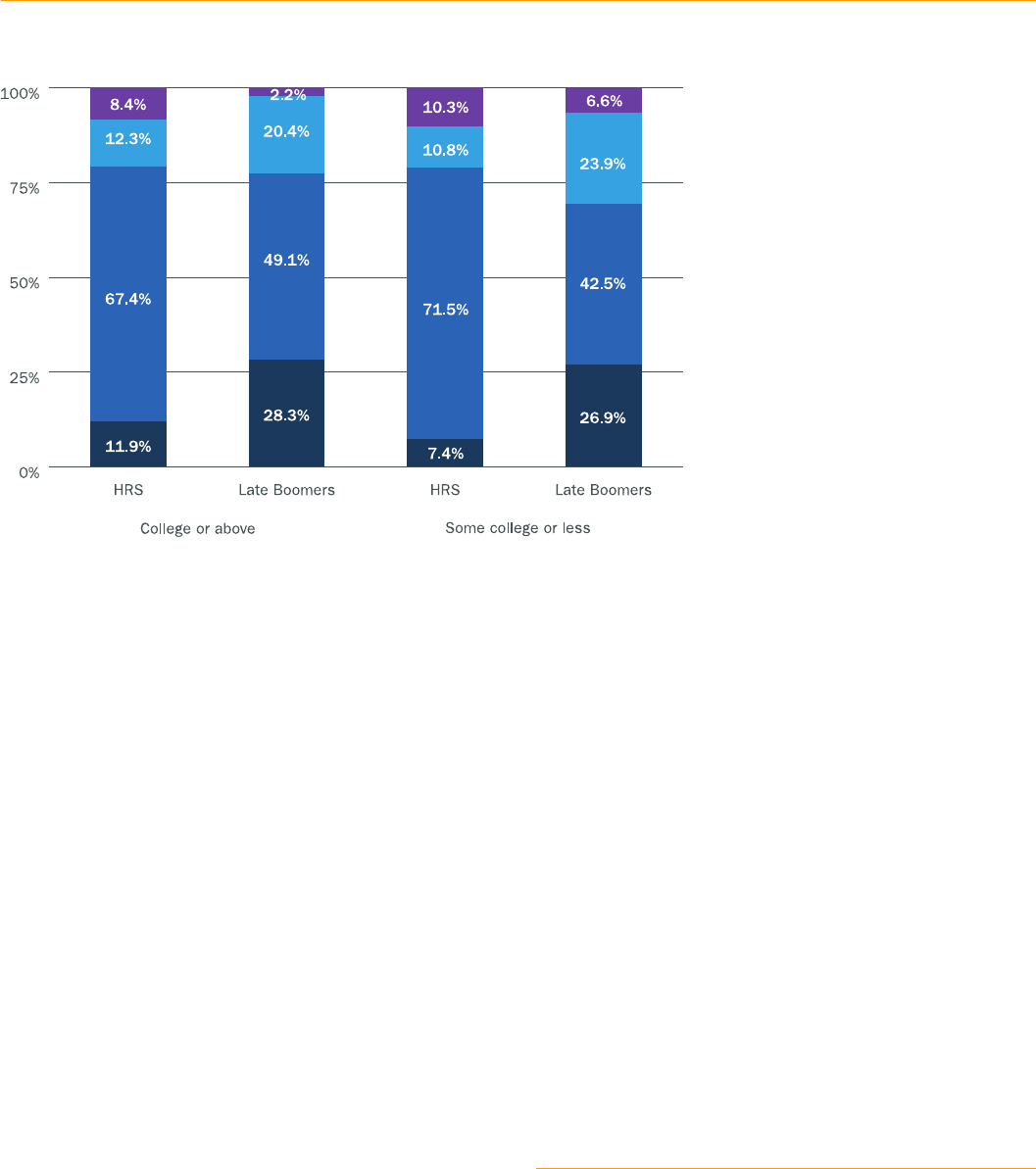
After 50 years of progress, how prepared are women for retirement? 11
Figure 10. Percentage of years widowed, divorced, married, and not married, by cohort and education
Source: Authors’ calculations from the HRS (1992-2020).
The bottom line is that women as a group have moved
from a situation where they spend most of their adult life
married to one where they spend less than half of their
adult life as part of a couple. Thus, to assess retirement
preparedness of women, it is necessary to consider both
changes in family structure as well as patterns of wealth
accumulation by cohort.
Changes in wealth accumulation and
retirement preparedness of women
The ultimate goal of the analysis is to determine the
extent to which women are prepared for retirement
and how their situation may have changed over time.
9
Preparation for retirement is measured in two ways.
(Details of both calculations are presented in the
Appendix.)
The rst is household wealth, which includes: 1) Social
Security wealth as measured by the expected discounted
value of future benets; 2) wealth in employer-sponsored
retirement plans, including both 401(k)-type and IRA
balances and the present discounted value of expected
benets from a dened benet plan; 3) nancial assets
less any outstanding debt; and 4) the value of the
primary residence less any outstanding mortgage debt.
While wealth measures provide useful insights into trends
across cohorts, the ultimate purpose of that wealth is
to allow households to maintain their standard of living
in retirement. Therefore, preparation for retirement is
also measured in terms of replacement rates—the ratio
of the retirement income that could be generated by
a household’s retirement resources divided by its pre-
retirement income.
Table 3 shows how wealth has changed across cohorts
for women and men. One decision is how to characterize
the wealth of one member of a married household. This
analysis assigns the couple’s full value to the woman and
to the man. Although this approach clearly overstates the
holdings of married people, it provides a clear benchmark
against which to compare trends over time. The numbers
are presented in 2020 dollars and represent the average
for the middle quintile of the wealth distribution.
9 This stage of the analysis will expand on Hou and Sanzenbacher (2021), who
assess retirement preparedness for households in the HRS by race and ethnicity.
The analysis will compare retirement readiness when the head of household is
ages 58-61 (age will vary depending on birth cohort and the timing of HRS survey
interviews).
● Widowed
● Divorced
● Married
● Not married

After 50 years of progress, how prepared are women for retirement? 12
Two patterns are evident in Table 3. First, wealth has
been declining across cohorts for both men and women.
This decline is largely due to two factors: 1)lower Social
Security wealth asthe increase in the Full Retirement Age
reduced benets for all; and 2) fewer assets in retirement
plans because of adverselabor market experiences
during the Great Recession. The second, and for the
purpose of this study, more interesting result is the
ratio of women’s wealth to men’s wealth. For the earlier
cohorts, the women’s wealth equaled 82-85 percent of
men’s; for the later cohorts, the comparable gures were
90-93 percent. Boomer men, who did not enjoy gains in
education or earnings over time, appear to have been hit
much harder than their female counterparts by the Great
Recession.
The question is the extent to which the overall
improvement in women’s wealth relates to their marital
status. Table 4 presents the wealth holdings for three
groups of women: 1) never married; 2) mostly single (less
than 50 percent of adult years married); and 3) mostly
married (more than 50 percent of adult years married).
The large decline in median wealth for women who
spend their lives mostly married largely reects declining
fortunes for their husbands, who felt the full impact of
reduced Social Security wealth and the Great Recession
without a countervailing increase in earnings. Since the
wealth of the mostly-single and never-married women has
remained relatively stable, their holdings have increased
sharply relative to the mostly married. For the Late
Boomer cohort, the relevant percentages are 65 percent
for the mostly-single and 48 percent for the never-married
women. Those percentages are high, given that, as noted
above, the mostly-married wealth belongs to two people.
Thus, in terms of wealth, women do not appear to have
undone their economic gains by changing their marriage
patterns.
Table 3. Median retirement wealth at ages 59–60 for households by gender and cohort, 2020 dollars
Table 4. Median wealth at ages 59–60 for women by lifetime marital status and cohort, 2020 dollars
Cohort
Gender HRS Cohort War Babies Early Boomers Mid Boomers Late Boomers
All women $480,600 $543,500 $445,000 $379,800 $335,400
All men 588,700 638,900 479,600 419,800 373,300
Women's wealth as a % of men's 82% 85% 93% 90% 90%
Cohort
Lifetime marital status HRS Cohort War Babies Early Boomers Mid Boomers Late Boomers
Mostly married $579,400 $731,400 $646,000 $530,700 $446,400
Mostly single 226,500 333,800 285,600 259,700 290,400
Never married 297,400 226,200 232,600 223,400 216,000
As a % of mostly married;
Mostly single 39% 46% 44% 49% 65%
Never married 51
*
31 36 42 48
Note: Median is measured as the average for the middle quintile of the wealth distribution.
Source: Authors’ calculations from the HRS (1992-2020).
* This number appears to reect noise from a small sample size rather than the earnings of never-married women.
Source: Authors’ calculations from the HRS (1992-2020).

After 50 years of progress, how prepared are women for retirement? 13
Table 5 repeats the same calculations for Black women.
Because the sample sizes by cohort, race, and marital
status are relatively small, the calculations collapse the
pre-Title IX cohorts—the HRS and the War Babies—and
those who mainly entered their 20s after Title IX—
namely, the Early, Mid, and Late Boomers. Although the
wealth levels are lower for Black women than for women
in general, the pattern of mostly-single and never-married
women gaining on the mostly married is similar to that of
women generally.
Table 5. Median wealth at ages 59–60 for Black women by lifetime marital status and cohort, 2020 dollars
Cohort
Lifetime marital status
HRS/
War Babies
Early, Mid, and
Late Boomers
Mostly married $334,600 $343,400
Mostly single 180,600 199,900
Never married 101,800 152,500
As a % of mostly married;
Mostly single 54% 58%
Never married 30 44
Source: Authors’ calculations from the HRS (1992-2020).
The ultimate purpose of retirement wealth, however, is
to support people’s pre-retirement standard of living in
retirement. So, Tables 6 and 7 repeat the exercise for
replacement rates, projected retirement income as a
percentage of pre-retirement earnings. In this exercise,
retirement income is based on annuitizing non-housing
wealth at ages 59-60 and pre-retirement income is set
at the ve years of highest earnings before age 55.
10
Housing is excluded because, as much as experts urge
them to do so, homeowners rarely tap their equity to
support themselves in retirement. The level of reported
replacement rates is lower than they will be ultimately,
because these households are 59-60 and still have
several years more to work and save before they retire.
The pattern of replacement rates across cohorts mirrors
the pattern of wealth in that mostly-single and never-
married women have gained relative to the mostly
married. But the story is slightly more complicated.
Mostly-married women have seen a sharp decline in
replacement rates due to two factors. First, the increase
in Social Security’s Full Retirement Age reduced benets
for all. While women’s improved economic success
acted as a countervailing force, men had no offsetting
gains and, therefore, absorbed the full impact of the FRA
increase. Second, household replacement rates have
further declined as the increased labor force participation
of married women has led to a dramatic decline in
the prevalence of the 50-percent spousal benet. (At
the extreme, if both members of a couple have the
same earnings, they get no spousal benet and their
replacement rate is equal to the husband’s rate alone,
whereas a household getting a full spousal benet would
have a replacement rate that is 50 percent higher.)
11
At the same time, never-married Boomers have seen
higher replacement rates than the earlier cohorts, while
replacement rates for the mostly-single women have
declined only slightly. Again, the conclusion is that women
foregoing marriage for some or all of their life have not
sacriced economic security. Just as their wealth has
increased relative to their married counterparts, so too
have their replacement rates become more equal.
10 Non-housing wealth includes the discounted value of Social Security benets;
wealth in all employer-sponsored retirement plans and balances in IRAs; and
nancial assets less outstanding debt.
11 When most women did not work, the wife who claimed at age 65 was entitled
to a benet equal to 50 percent of that of her husband’s, so if the replacement
rate for the typical worker was 40 percent, the replacement rate for the couple
would be 60 percent. As women went to work, however, the calculation became
less obvious, since women were entitled to the larger of the spouse’s benet or
the benet they could earn on their own. When women’s earnings were modest,
their wages increased the couple’s pre-retirement income, but did not increase
the total amount the couple received from Social Security. As women’s wages
became equal to their husband’s, the replacement rate for the couple with two
typical workers would be 40 percent.

After 50 years of progress, how prepared are women for retirement? 14
Finally, Table 7 reports replacement rates for Black
women—again comparing the HRS/War Babies and the
Boomers. Because of the progressive nature of Social
Security, despite having less wealth, Black women have
replacement rates roughly equal to those for women as
a group. And the pattern over time is similar. Women
who spend most of their life married have experienced
a decline in replacement rates, while the mostly single
and never married have seen increases. Like the story
for women as a group, the replacement rates for mostly-
single and never-married women have reached and now
even exceed those for women who spend their lives
mostly married.
Table 6. Median replacement rate at age 59–60 for women by lifetime marital status and cohort
Cohort
Lifetime marital status HRS Cohort War Babies Early Boomers Mid Boomers Late Boomers
Mostly married 44% 47% 44% 38% 35%
Mostly single 36 36 36 33 33
Never married 43
*
24 37 34 34
*This number appears to reect small sample size rather than the earnings of never-married women.
Note: Median is measured as the average for the middle quintile of the wealth distribution.
Source: Authors’ calculations from the HRS (1992-2020).
Table 7. Median replacement rate at age 59–60 for Black women by lifetime marital status and cohort
Cohort
Lifetime marital status
HRS/
War Babies
Early, Mid, and
Late Boomers
Mostly married 37% 33%
Mostly single 32 34
Never married 26 38
Source: Authors’ calculations from the HRS (1992-2020).

After 50 years of progress, how prepared are women for retirement? 15
Conclusion
In the half century since Title IX’s passage, women
have made substantial economic progress. The key
comparison in this study is between Baby Boomers, who
were reaching adulthood in the wake of Title IX, and prior
generations. Baby Boomer women are much more likely
to have college degrees and the Mid to Late Boomers
have even surpassed men on this metric. Women’s
labor force participation rates have also risen sharply,
particularly for married women. Not surprisingly, women
are earning more as well. The economic status of both
Black and White women has improved over this period,
though Whites have seen greater progress than their
Black counterparts.
While these economic advancements are encouraging,
the focus of this study is on the extent to which
women are prepared for retirement. One factor that
could potentially undermine women’s economic gains
during their working lives is a change in their living
arrangements. In recent decades, women are more likely
to live independently, with the Late Boomers spending
only 44 percent of their adult lives married compared to
over 70 percent for the oldest cohorts. Baby Boomers
are more likely to have married later, gotten divorced,
and never married at all. These overall trends have been
similar by race, but White women have seen a bigger
surge in divorces, while Black women have experienced
a larger increase in the never-married group. This
movement away from marriage, by reducing the potential
support of a spouse, could have put women more at risk
economically.
Strikingly, though, the results show that it is the women
who have spent most of their lives married who look
worse off in terms of retirement preparedness. Compared
to earlier cohorts, they have seen signicant drops in
their retirement wealth and in their replacement rates.
The reason is, in large part, the declining economic
fortunes of their husbands, who experienced the full
impact of the rise in Social Security’s Full Retirement Age
and labor market setbacks during the Great Recession
without countervailing improvements in education and
earnings. Additionally, mostly-married couples have
seen a drop in replacement rates due to their declining
eligibility for Social Security’s spousal benet. In
contrast, mostly-single and never-married women have
gained ground on those who are mostly-married. These
overall patterns are similar for both White and Black
women. The conclusion, then, is that women do not
appear to have undone their economic gains since Title
IX’s passage by opting to spend more time on their own.
They have gained both income and wealth, and are as
well prepared for retirement as married couples.

After 50 years of progress, how prepared are women for retirement? 16
References
Butrica, Barbara A. and Karen E. Smith. 2012a. “The Impact of Changes in Couples’ Earnings on Married Women’s
Social Security Benets.” Social Security Bulletin 72(1): 1-10.
Butrica, Barbara A. and Karen E. Smith. 2012b. “The Retirement Prospects of Divorced Women.” Social Security
Bulletin 72(1): 11-22.
Butrica, Barbara A., Karen E. Smith, and Howard M. Jams. 2012. “This Is Not Your Parents’ Retirement: Comparing
Retirement Income Across Generations.” Social Security Bulletin 72(1): 37-58.
Fang, Chichun, Charles Brown, and David Weir. 2016. “Cohort Changes in Social Security Benets and Pension
Wealth.” Working Paper 2016-350. Ann Arbor, MI: University of Michigan Retirement Research Center.
Fang, Chichun and Kandice Kapinos. 2016. “Health and Retirement Study Prospective Social Security Wealth Measures
of Pre-Retirees.” Version 1.0. Ann Arbor, MI: University of Michigan, Institute for Social Research.
Goldin, Claudia. 2006. “The Quiet Revolution that Transformed Women’s Employment,Education, and Family.”
American Economic Review 96(2): 1-21.
Goldin, Claudia and Lawrence F. Katz. 2002. “The Power of the Pill: Oral Contraceptives and Women’s Career and
Marriage Decisions.” Journal of Political Economy 110(4): 730-770.
Gustman, Alan L., Thomas L. Steinmeier, and Nahid Tabatabai. 2010. Pensions in the Health and Retirement Study.
Cambridge, MA: Harvard University Press.
Gustman, Alan L., Thomas L. Steinmeier, and Nahid Tabatabai. 2014. “The Great Recession, Decline and Rebound in
Household Wealth for the Near Retirement Population.” Working Paper 20584. Cambridge, MA: National Bureau of
Economic Research.
Iams, Howard M., John W. R. Phillips, Kristen Robinson, Lionel P. Deang, and Irena Dushi. 2009. “Cohort Changes in
the Retirement Resources of Older Women.” Social Security Bulletin 68(4): 1-13.
Haines, Michael R. 1996. “Long-Term Marriage Patterns in the United States from Colonial Times to the Present.”
The History of the Family 1(1): 15-39
Hou, Wenliang and Geoffrey T. Sanzenbacher. 2021. “Measuring Racial/Ethnic Retirement Wealth Inequality.”
Journal of Retirement 8(3): 12-28.
Loughran, David S. 2002. “The Effect of Male Wage Inequality on Female Age at First Marriage.” The Review of
Economics and Statistics 84(2): 237-350.
Lundberg, Shelly, Robert A. Pollak, and Jenna Stearns. 2016. “Family Inequality: Diverging Patterns in Marriage,
Cohabitation, and Childbearing.” Journal of Economic Perspectives 30(2): 79-102.
Mitchell, Olivia S. and James F. Moore. 1997. “Retirement Wealth Accumulation and Decumulation: New Developments
and Outstanding Opportunities.” Working Paper 6178. Cambridge, MA: National Bureau of Economic Research.
Mitchell, Olivia S., Jan Olson, and Thomas L. Steinmeier. 2000. “Social Security Earnings and Projected Benets.” In
Forecasting Retirement Needs and Retirement Wealth, edited by Olivia S. Mitchell, P. Brett Hammond, and Anna M.
Rappaport, 327-360. Philadelphia, PA: University of Pennsylvania Press.
Munnell, Alicia H., Geoffrey T. Sanzenbacher, and Sara Ellen King. 2017. “Do Women Still Spend Most of Their Lives
Married?” Issue in Brief 17-14. Chestnut Hill, MA: Center for Retirement Research at Boston College.
Munnell, Alicia H., Geoffrey Sanzenbacher, and Mauricio Soto. 2007. “Working Wives Reduce Social Security
Replacement Rates.” Issue in Brief 7-15. Chestnut Hill, MA: Center for Retirement Research at Boston College.
Purcell, Patrick J. 2012. “Income Replacement Ratios in the Health and Retirement Study.” Social Security Bulletin
72(3): 37-58.

After 50 years of progress, how prepared are women for retirement? 17
Raley, Kelly R., Megan M. Sweeney, and Danielle Wondra. 2015. “The Growing Racial and Ethnic Divide in U.S.
Marriage Patterns.” Future Child 25(2): 89-109.
Stevenson, Betsey and Justin Wolfers. 2007. “Marriage and Divorce: Changes and Their Driving Forces.”
Journal of Economic Perspectives 21(2): 27-52.
Wu, April Yanyuan, Nadia S. Karamcheva, Alicia H. Munnell, and Patrick Purcell. 2013. “How Do the Changing Labor
Supply Behavior and Marriage Patterns of Women Affect Social Security Replacement Rates?” Working Paper 2013-
16. Chestnut Hill, MA: Center for Retirement Research at Boston College.

After 50 years of progress, how prepared are women for retirement? 18
Technical appendix
The analysis draws from the Health and Retirement Study (HRS), a nationally representative longitudinal survey that has
interviewed people over age 50 every two years since 1992. It uses all 15 waves of the HRS (1992-2020) to examine
the wealth and changing demographics of women in different birth cohorts.
It also supplements the HRS with restricted
administrative earnings data provided by the U.S. Social Security Administration (SSA).
Documenting women’s lifetime marital status
The calculation of the percentage of years spent married is based on detailed survey questions about current and past
marital status.
12
Women in earlier cohorts are followed until 2020, when most are well into their eighties or beyond.
However, later cohorts cannot be observed beyond their mid-to-late fties. To address potential bias from truncating
the observation period, we adjust the estimates for later cohorts based on how the oldest cohorts fared as they
aged beyond their fties. This adjusted estimate starts with the ratio of the percentage of years spent married for the
(oldest) HRS cohort as of 2020 to the percentage for this same cohort at ages 54-60:
This ratio is then applied to the reported percentages at ages 54-60 for the younger cohorts. The adjusted share of
years married is then used to categorize women into three groups: 1) never married; 2) mostly single (less than 50
percent of adult years married); and 3) mostly married (more than 50 percent of adult years married).
Calculating household wealth
The analysis includes all sources of retirement wealth: 1) Social Security wealth as measured by the expected
discounted value of future benets; 2) wealth in employer-sponsored retirement plans, including both dened
contribution and IRA balances and the present discounted value of expected benets from a dened benet plan; 3)
nancial assets less any outstanding debt;
and 4) the value of the primary residence less any outstanding mortgage
debt. The method for calculating each wealth component is described below.
Social Security. The calculation of Social Security wealth is common in the literature.
13
The starting point is the
individual’s annual Social Security benet, which is a function of Average Indexed Monthly Earnings (AIME) and claiming
age. The AIME calculation relies on a link between the publicly available HRS and the restricted SSA earnings data.
14
The annual benet is calculated from AIME using a legislated formula, assuming that individuals claim at their Full
Retirement Age. To convert this annual income stream to a measure of wealth, future benet ows are adjusted for
legislated cost-of-living adjustments and the probability that individuals are still living, and then discounted back to age
60.
15
For married women, household Social Security wealth includes not only individual benets for both spouses, but
also the present discounted value of spousal and survivor benets, adjusted for the probability of receipt.
Employer-Sponsored Retirement Plans. For both dened benet (DB) and dened contribution (DC) retirement plans,
we follow Gustman et al. (2010) to calculate wealth based on self-reported data. DB wealth is based on estimates of
pension income at the participant’s expected retirement age. Similar to Social Security, the analysis takes this income
stream and calculates the expected present value of lifetime benets.
16
Respondents who report having a DC plan,
(1)
12 Women were eliminated from the sample in cases where the responses on marriage history are missing or inconsistent, such as a marriage starting before a previous one
ended.
13 See Fang and Kapinos (2016); Fang, Brown and Weir (2016); and Gustman, Steinmeier, and Tabatabai (2014).
14 For individuals who have yet to reach retirement age, future earnings are projected using a ve-year weighted average of their past earnings, rolled forward each year (see
Mitchell, Olson and Steinmeier 2000 for a detailed description of the methodology).
15 Assumptions about ination and real interest rates are drawn from the Social Security Trustees Report. Survival probabilities are drawn from SSA life tables by birth year
and sex.
16 As in Mitchell and Moore (1997) and Gustman, Steinmeier, and Tabatabai (2010).

After 50 years of progress, how prepared are women for retirement? 19
such as a 401(k) or 403(b), in either their current job or a previous one are asked for the account balance. DC wealth is
simply the total balance of all accounts, plus the balance of any IRA accounts.
Housing Wealth. Housing wealth is dened as the net value of the primary residence, which is calculated as the gross
value of the primary residence less any relevant mortgages and home loans. For households where debt exceeds
equity, housing wealth is allowed to be negative.
Financial Wealth. Financial wealth includes the net value of stocks, mutual funds, bonds and bond funds; the value
of checking, savings, and money market accounts; certicates of deposit; and government savings bonds (excluding
holdings of any of these assets in DC plans or IRAs); minus non-housing debt. For households where debt exceeds
assets, nancial wealth is allowed to be negative.
Calculating replacement rates
The analysis also calculates the replacement rate for each household, which is the ratio of the retirement income that
could be generated by the household’s resources divided by its pre-retirement income. The numerator of this ratio is
estimated by converting wealth totals to annual ows assuming that households purchase an actuarially fair single-
life immediate annuity. Although few households voluntarily annuitize wealth, annuities are a proxy for a sustainable
withdrawal rate. For the denominator, the analysis takes the average of the highest ve years of household earnings
before age 55, based on the SSA administrative earnings records.

After 50 years of progress, how prepared are women for retirement? 20
About the authors
Alicia H. Munnell is the Peter F. Drucker Professor of Management Sciences at Boston College’s Carroll School of
Management. She also serves as the director of the Center for Retirement Research at Boston College.
Before joining Boston College in 1997, Alicia Munnell was a member of the President’s Council of Economic Advisers
(1995-1997) and assistant secretary of the Treasury for economic policy (1993-1995). Previously, she spent 20 years
at the Federal Reserve Bank of Boston (1973-1993), where she became senior vice president and director of research
in 1984. She has published many articles, authored numerous books, and edited several volumes on tax policy, Social
Security, public and private pensions, and productivity.
Alicia Munnell was co-founder and rst president of the National Academy of Social Insurance and is currently a
member of the American Academy of Arts and Sciences, Institute of Medicine, and the Pension Research Council at
Wharton. She is a member of the board of The Century Foundation, the National Bureau of Economic Research, and the
Pension Rights Center. In 2007, she was awarded the International INA Prize for Insurance Sciences by the Accademia
Nazionale dei Lincei in Rome. In 2009, she received the Robert M. Ball Award for Outstanding Achievements in Social
Insurance from the National Academy of Social Insurance. In 2015, she chaired the U.S. Social Security Advisory
Board’s Technical Panel on Assumptions and Methods.
Alicia Munnell earned her B.A. from Wellesley College, an M.A. from Boston University, and her Ph.D. from Harvard
University.
Siyan Liu is a research economist at the Center for Retirement Research at Boston College. Her research interests
are in the nancial well-being of older workers, retirement preparedness, and public pension plans. Before joining the
center, Liu earned a Ph.D. from North Carolina State University in the eld of labor economics. She holds a M.A. in
economics from Vanderbilt University and a B.B.A. from the University of Hong Kong.
Laura D. Quinby is a senior research economist at the Center for Retirement Research at Boston College. She conducts
research on state and locally administered retirement programs—including pensions, disability and retiree health
insurance, Medicaid, and state initiatives to expand private-sector coverage—as well as Social Security. Quinby earned
a Ph.D. in public policy from Harvard University in the elds of labor economics and public nance. Her work appears
in academic journals, such as the Journal of Policy Analysis and Management and the Journal of Pension Economics and
Finance, as well as issue briefs that are widely cited by policymakers and the media.

After 50 years of progress, how prepared are women for retirement? 21
(06/22)
TIAA Institute is a division of Teachers Insurance and Annuity Association of America (TIAA), New York, NY. ©2022 Teachers Insurance and Annuity Association of America-College
Retirement Equities Fund, 730 Third Avenue, New York, NY 10017
About the TIAA Institute
The TIAA Institute helps advance the ways individuals and institutions plan for
nancial security and organizational effectiveness. The Institute conducts in-
depth research, provides access to a network of thought leaders, and enables
those it serves to anticipate trends, plan future strategies, and maximize
opportunities for success.
To learn more, visit www.tiaainstitute.org.
Join the conversation online:
@TIAAInstitute
